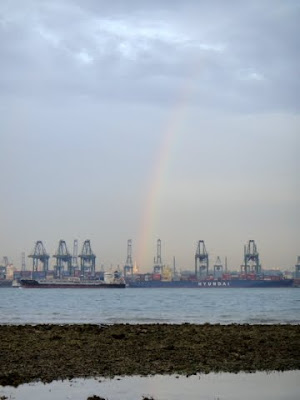It's time to be back at Cyrene Reef, one of my most favourite reefs to monitor the seagrasses. Swimming anemones on seagrass from Loh Kok Sheng on Vimeo. Swimming anemone @ Cyrene Reef from Loh Kok Sheng on Vimeo.
Despite the dark clouds in the near distance, we continued to land on Cyrene. And along the way, we passed by the North Pandan buoy (Cyrene is actually called Terumbu Pandan).
The tide was a little high while we landed with only the higher parts of the sand bar exposed. We went ahead with the monitoring work.

And I was surprised to see an explosion of tiny Swimming anemones (Boloceroides mcmurrichi) on the blades of the seagrasses!
Here's a video of the many anemones on the seagrass blades.
And here's one of the anemones swimming in action! :)
At the 25m mark, I came across a special snail.

This snail is called the Spurred turban snail (Astraea calcar). Calcar means 'spur', which explains why the outer shell has a spiral of blunt bumps and spikes.
Here's another special snail, the Eggwhite moon snail (Neverita albumen). In fact it's only the second time I've ever seen this. The first time was at Changi.
This snail has a huge white body. It achieves such a size by inflating itself with seawater.
While the body is shrunk into its shell, you can see a deep U-shaped depression on the white underside.
That's not all, I also saw a living Button snail (Umbonium vestiarium) for the first time at Cyrene! However, I couldn't any other snails of the same species. They usually aggregrate together in huge numbers.
On the reefy side, I saw a bright orange object. Upon closer look, it is actually a Fireband Murex (Chicoreus torrefactus)!
On the sandier areas, I came across some anemones including this colourful and banded juvenile Peacock anemone (Order Ceriantharia).

It's always a joy to have so many Knobbly sea stars (Protoreaster nodosus) at every Cyrene trip. However, I noticed that they seem to be heading towards the deeper ends of the shore. Some of them were at the edge of the reef. These stars have grown to be bigger and with more knobs now.

Cyrene Reef is possibly the last couple of remaining shore that has a sustainable population of these stars. Young ones are still abundantly seen at the seagrass meadows.
Nearing to sunset, I stumbled across this group of stars aggregrating together!
At a distance, there was a pretty rainbow, nice!
And we ended the trip with a magnificent sunset in purplish clouds.
As it was drizzling during the trip and that we had to conduct the transect, I didn't really have a good look to see if Cyrene is ok. The tape seagrasses are not doing well and some blades of other seagrasses are black. I hope this is not a bad sign for the marine life here.
More photos of the trip here: http://www.flickr.com/photos/koksheng/archives/date-taken/2010/12/06/
Wednesday, December 8, 2010
Cyrene reef with Teamseagrass
Subscribe to:
Post Comments (Atom)

















No comments:
Post a Comment